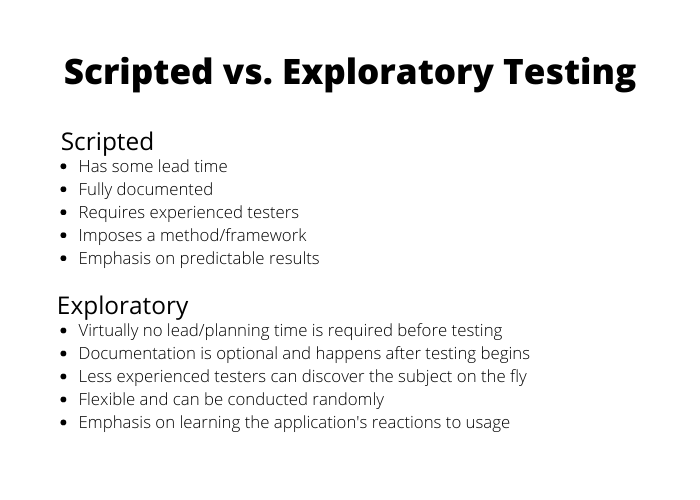In this post, we’re going to focus more on the scripted method of testing applications, starting with a look at its use cases and the advantages thereof. We’ll also examine tools that use scripted testing concepts to improve the quality of your applications.
Before we get into the details of scripted testing, a glance into its history should serve as a solid foundation for a complete comprehension of the matter. As with everything, laying out a clear definition of the subject is the way to put our best foot forward.
What Is Scripted Testing?
Assuming prior knowledge of what testing is, the scripted part in this approach dictates that QAs write the entire process before its execution. These writings can include detailed steps through which a tester will have to go during the process. It often also includes predictable results for each test stage (step), deviation from which would be proof of a defect.
You can automate the tests or revert to a manual approach.
When to Use Scripted Testing
While it takes a lot of preparation to execute a scripted test, they often provide quicker results. This is especially true when running tests for chunky software programs or even precision-sensitive apps (financial tools, for instance).
The following scenarios make scripted tests the best method:
- When there are too many test areas and you can’t risk skipping any
- Cases where iterations are necessary to ensure the precision of a test
- When speed is more important that user involvement
In a nutshell, scripted tests are perfect when you want to lessen the room for error, while maximizing on accuracy and speed.
Advantages and Disadvantages of Scripted Testing
Sometimes (solely) using scripted testing doesn’t get the desired results. To understand this, let’s look at a few advantages and disadvantages of using scripted testing on its own.
Advantages of Scripted Testing
- Scripted testing finds functional defects quickly.
- Prior documentation of the process makes it easy to replicate when needed.
- You can rerun scripted tests in an automated way without much additional effort.
Disadvantages of Scripted Testing
- The prior work requirement makes scripted tests time intensive.
- You’ll need skilled testers to write (code) the test scripts.
- It limits the range of defects discoverable to the results template in the script.
- If you change the code of the application, you will likely need to update your scripts.
Despite these limitations, the advantages inherently make scripted testing a key method for automated testing. To cover the shortfalls we’ve listed above, many testing systems often include multiple approaches to testing so that each approach provides some advantages that offset the disadvantages.
Let’s examine how this hybrid approach to software testing has led to better applications.
How Software Testing Has Developed Over Time
Just as a software program undergoes changes during its development phase, so too do the methods to test it. While in the early stages, it wouldn’t be wise to run long tests when short tests will suffice. As such, we’d need to execute the alternative to scripted testing: exploratory testing.
At this stage, we won’t put the two options up against each other. Instead, we’ll discuss how each of their features complements the other’s. To achieve this, let’s look under the hood of exploratory testing in the same way we did for scripted testing.
The Exploratory Angle to Software Testing
As you might expect from the name, this testing method takes on a free-form approach to finding errors in software applications. Not that it happens with little planning, but strictly that there’s no documentation or steps directing the tester as they engage with the application.
Test results from two different testers using the exploratory approach may look totally different, even though they were performed on the same piece of software. The tester, in this case, makes up the script as they actually use the software.
You may have already seen how the exploratory route could benefit someone planning to carry out scripted tests. Once the steps and interactions taken by an explorer are recorded, we can create and run scripted automation that follows the exploratory path. Automation used this way can execute at paces quicker than a human would. Add that to the fact that manually mapping out a script this way mimics the way an actual (intended) user would use the system, and you have a potentially more thorough script.
Key Differences Between Scripted and Exploratory Software Testing
When placed side to side, it’s easy to distill differences between the scripted and exploratory software testing methods. The table below does just that to highlight enough disparities for a clearer understanding both methods.

How Tools Use Scripted Testing Today
Many testing tools today offer a mix of the two approaches described above. They start with a recording following a user’s experience in the application (similar to exploratory testing). Then they convert the recording to a script or configurable tests. This process enables quick authoring of common application scenarios that can be repeated with automation.
Once you have a core set of test cases written, you can start to focus on expanding your test coverage to include lesser-used, edge cases. This approach merges the intuitive user approach of an exploratory tester, with the application-specific knowledge of a QA automation engineer or developer.
Something amazing happens when we factor in some artificial intelligence to testing. Instead of having a rigid test that must change for every application code update, the test can adapt and heal. Unlike the shortcomings of scripted testing, the modern Low Code approach can offer a fast yet flexible approach that includes the stability of AI.
The Future of Software Testing
More and more applications hit the market daily, which implies that thousands of tests are running as you read this. If each test is an opportunity to improve both the application and the testing process itself, we could well be in line to witness more intuitive tests in the near future. Tools equipped with AI (like Testim) learn from their tests and improve stability.
Exploratory testing and some amount of manual testing will almost certainly be needed for the foreseeable future. However, modern testing tools are making test authoring and stability much easier. They are reducing the need to write scripted tests that are slow and take skilled resources.
You can read more about the future of testing with this resource we’ve compiled.




